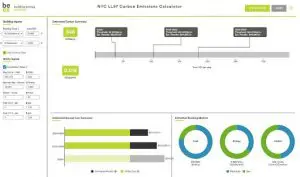What Is NYC Local Law 97?
In order to better understand what Local Law 97 is, we need to understand how and why it came about. The origin of this law comes from a generally unknown and rather astounding fact about New York City (NYC): buildings account for a whopping 71% of the city’s greenhouse gas emissions, surpassing even transportation emissions!
In order to address this issue, the NYC Council passed the NYC Climate Mobilization Act (CMA) in 2019. Also known as NYC’s Green New Deal, it comprises several laws aiming to reduce NYC’s building carbon or greenhouse emissions by 40% by 2030 and by 80% by 2050. At the time, the NYC CMA was the largest and most ambitious climate legislation passed by any city in the world. This law affects 50,000 of NYC’s one million buildings.
How Do CMA Requirements Reduce Buildings’ Carbon Emissions?
CMA requires that owners of residential and commercial buildings over 25,000 square feet in size invest in renovation and retrofitting to make their buildings more energy efficient, and eventually meet the emissions caps that have been established. The total estimated cost to building owners in NYC is $4 billion USD, but some of these costs will likely create future energy savings as well.
What Are Some Ways To Become Compliant with Local Law 97?
Building owners can consider investing in better-insulated windows, dimmable lights, and more efficient air conditioners and heating systems.
Who Is Required to Do Retrofits?
Buildings over 25,000 square feet. If your building meets this threshold, there are two initial phases of emissions caps or limits for eligible buildings set by Local Law 97. The first phase begins in 2024 and continues until 2029, while the second, more stringent phase will take place from 2030 through 2034. The caps or limits were set based on several different building use classifications and sizes.
Where Can the New Emission Requirements Be Found?
A good place to check on the status of a building is the Building Energy Exchange (be-exchange.org/calculator/). A building’s yearly emissions reports should already be linked at this website, as all eligible buildings are required to submit annual energy audits by the previously enacted Local Law 84. If a building has not submitted these reports, an engineering firm should be engaged to perform a Local Law 97 energy audit.
How Are the Requirements Calculated and Determined?
The emissions intensity limits set by Local Law 97 were determined for 10 classifications of buildings based on Building Code occupancy groups. A building’s annual emissions limit is its emissions intensity limit multiplied by floor area. Below is an example of a building Carbon Emissions Calculator result for a pre-war building (Bldg. A as an example) that is just above 25,000 square feet in size:

What Are the Penalties for Non-Compliance?
The penalty for not complying with Local Law 97 is a fine, calculated by taking the difference between a building’s annual allowable emissions limit and its actual emissions, then multiplying the difference by $268/square foot. The law establishes a fine of $268 for each metric ton of CO2 a building emits over the allowable amount established for each year.
For example, the building referenced above (Bldg. A) is comprised of 22,483 square feet of residential apartments on the 2nd through 7th floors (Occupancy Group R-2), and the ground floor features a 3,000-square-foot restaurant (Occupancy Group A). Based on the building occupancy, the allowable GHG emissions for this property are calculated as follows:

Bldg. A has been filing its annual energy benchmarking reports in accordance with Local Law 84 and the latest GHG emissions report indicates a total of 346 tCO2e/year, which is 162 tCO2e/year over the 2024-2029 allowable limits. The Local Law 97 penalty assessment for this property would be as follows:
Current GHG Emissions = 346 tCO2e/year (162 tCO2e/year over allowable)
Fine Assessment: 162 tCO2e/year x $268.00 = $43,416.00/year
The allowable GHG emissions are decreased to 104 tCO2e/year for the second phase of Local Law 97 in the years 2030-2034. The penalty for this property would increase to $65,000/year if no energy conservation measures are implemented to reduce the current amount of annual GHG emissions.
How Rimkus Can Help?
Rimkus offers a program to perform a comprehensive analysis of both the building mechanical systems and envelope assemblies to provide the owners with a wholistic view of where energy is being lost and what steps may be taken to bring their property into compliance with the Local Law 97 regulations.